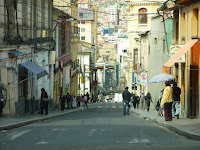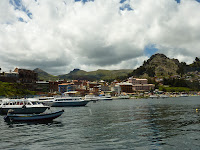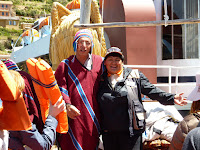We arrived in La Paz via bus from Lake Titicaca the entry to
the city is via El Alto, which is a satellite city of La Paz; it is also where
the airport is situated and has an elevation of 4200 metres.
La Paz is built on very steep hills and varies in Elevation
from 3000 to 4100metres, whilst in most cities the richer people live on the
hills, in La Paz the opposite occurs with the poorer people living in make
shift houses on the hills.
There were a lot more people here in traditional dress
including women wearing the bowler hat.
 We had been watching the cold temperatures in La Paz but
were surprised that it was not that cold, our guide explained that the temp
could vary by up to 12 degrees depending on how far down the hill you are. The
official measurement is done at the airport which is at 4000 metres and thus is
always much colder than the city.
We had been watching the cold temperatures in La Paz but
were surprised that it was not that cold, our guide explained that the temp
could vary by up to 12 degrees depending on how far down the hill you are. The
official measurement is done at the airport which is at 4000 metres and thus is
always much colder than the city. The traffic is horrendous as all the roads are narrow and
steep. In addition there was a demonstration on the day we were leaving with
the roads to the airport blocked so we had to go to the airport 2 hours earlier
than planned to allow time to get around the roadblocks.
The traffic is horrendous as all the roads are narrow and
steep. In addition there was a demonstration on the day we were leaving with
the roads to the airport blocked so we had to go to the airport 2 hours earlier
than planned to allow time to get around the roadblocks.
We did manage to fit in a tour of the city and a visit to
the “Witches Market”, this is where the ingredients for traditional remedies
can be purchased for ceremonies held by the Aymara people – yes that is a llama
foetus

We also visited a very unusual geographical formation called the “Valley of the Moon” an area where erosion has worn away the majority of the mountain leaving the effect of giant stalagmites.
We are on our way home now - so this is the final posting on this blog.
























































